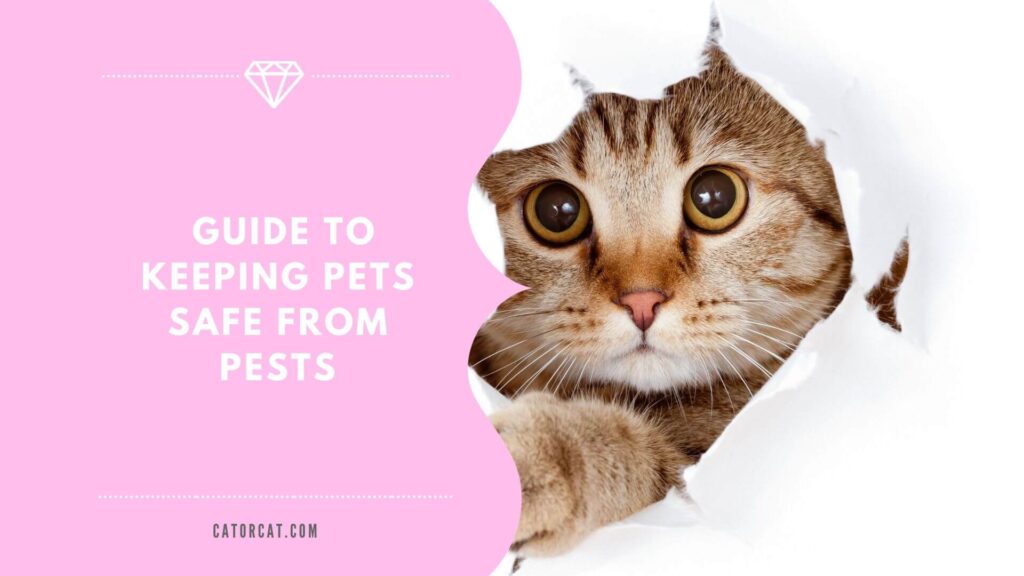
Whether you have a loyal pup wagging its tail at your feet or a furry feline snuggled up on your lap, one thing is for sure – pets bring joy and companionship into our lives. We must ensure their safety and well-being as much as we love them. That’s why, in this blog post, we’ll dive into an essential guide on how to keep our beloved pets safe from pests.
From fleas and ticks to spiders and rodents, these unwanted critters can cause discomfort for our furry friends and put their health at risk. So sit back, grab your favorite four-legged companion (if they’re not too squeamish), and let’s learn how to protect them together.
1. Invest in Professional Pest Control Services
Preventative measures are crucial in pest control, but professional intervention is sometimes necessary. Pest control services have the expertise and resources to tackle pest problems effectively. They identify pest hotspots and implement strategies to eliminate infestations and prevent future ones. Using professional services offers peace of mind, protecting your home and pets from pests.
In Boston, MA, qualified pest control teams are experts in the local pest species and their behavior. This knowledge allows them to devise effective control measures and advise on early signs of infestation. Partnering with a professional pest control in Boston, MA, or anywhere else, proactively protects your pet and ensures your home is pest-free. This allows you to focus on enjoying quality time with your furry friend without worrying about pesky intruders.

2. Regular Vet Visits
Make sure your pet is up-to-date on all their vaccinations. Veterinarians are well-versed in comprehensive preventative measures and can offer personalized advice based on your pet’s breed, age, lifestyle, and health conditions. They can conduct routine check-ups to detect early signs of infestations, which may go unnoticed by untrained eyes, and promptly initiate effective treatment plans.
Vets can offer professional recommendations on preventative products. Pet owners can feel overwhelmed with countless flea and tick preventatives on the market. Your vet can guide you to the most suitable products based on your pet’s needs and show you how to apply them correctly for maximum effectiveness. A preventative approach is best to keep your pet comfortable and free from pests.
3. Maintain a Clean Environment
A clean home reduces the chances of pests finding food and breeding grounds, keeping your pets safe. Regular cleaning routines like vacuuming carpets, washing pet bedding, and clearing clutter discourage pests such as fleas and ticks. Maintaining a clean yard is also beneficial; trim bushes, mow the lawn regularly, and remove trash or stagnant water that could attract pests.
It’s important to clean and store pet food to prevent pests properly. Leaving it out or storing it improperly can attract unwanted critters. Keep pet food in sealed containers and promptly clean feeding areas after your pet finishes eating. Regularly cleaning the litter box is essential for cat owners as a dirty one can attract pests and harm your feline friend’s health. A clean environment benefits pest control and your pet’s overall well-being.
4. Groom Regularly
Regular grooming is essential for maintaining your pet’s health and preventing pests. This includes brushing their hair, checking their skin for signs of infection or infestation, and using pet-friendly, pest-repellent shampoos during baths. Regular grooming helps detect pests like fleas and ticks early, preventing them from becoming a major problem. It’s also a good time to check for any abnormalities that could indicate a pest issue, such as rashes or bumps.
Pets, especially dogs that spend time outdoors, may pick up pests. After each outing, quickly check their coat and skin for hitchhiking bugs. Pay extra attention to hidden areas like behind the ears, under the tail, and between the toes. If you find any pests, consult your vet for immediate treatment. Early detection is crucial for protecting your pet from pest-related conditions.

5. Feed Your Pets Indoors
Leaving pet food outside can attract pests like ants, rodents, and raccoons, posing a risk to your pets. Feed your pets indoors and promptly clean up any leftovers to prevent this. This deters pests and prevents other animals from entering your yard in search of food. Outdoor feeding can also lead to conflicts between your pets and wildlife, putting them at risk of injury or disease.
Indoor feeding helps monitor your pet’s food intake closely, promoting their overall health. It simplifies maintaining regular feeding patterns and portion control. It also reduces the risk of consuming spoiled or contaminated food. Though an adjustment, feeding your pet indoors is worthwhile for pest control and their well-being.
Related: Darwin’s Natural Cat Food
6. Use Pest-Proof Bedding
Investing in pest-proof bedding is another significant step in safeguarding your pets from annoying critters. These specially designed beddings are treated with safe and pet-friendly substances that repel pests like fleas and ticks. They provide a secure and comfortable space for your pets to rest, ensuring uninterrupted sleep without the worry of pests.
You can find a range of pest-proof bedding options available in the market, catering to different sizes, breeds, and needs of pets. Regularly wash and inspect these beddings for any signs of pest activity. It is also helpful to place your pet’s bed in a spot that is easy to monitor and clean. This strategic location further reduces the chances of pests causing discomfort to your four-legged friend.
7. Educate Yourself
Educating yourself about common pests in your area and their behavior can help you take the necessary precautions to protect your pets. Certain insects like mosquitoes and ticks are known carriers of diseases that can be transmitted to our pets through a simple bite. By learning how these pests operate, pet owners can employ proactive measures such as pest-proofing homes and yards, using preventative products, and seeking professional help.
Furthermore, understanding the signs of pest infestations can also help you take prompt action. For example, excessive itching or scratching may indicate your pet has fleas or ticks. In such cases, it’s important to consult with your vet for proper treatment methods and implement preventative measures to ensure a repeat infestation does not occur.
Protecting our pets from pests is crucial for responsible pet owners. Follow the tips in this guide to create a safe and pest-free environment for your pets. Prevention is key, so invest time and effort into keeping pesky critters away. Consult professionals if needed, educate yourself on pests in your area, and maintain a clean environment for your beloved pets. With these measures, you and your furry friends can enjoy happy moments together without worrying about pests.
